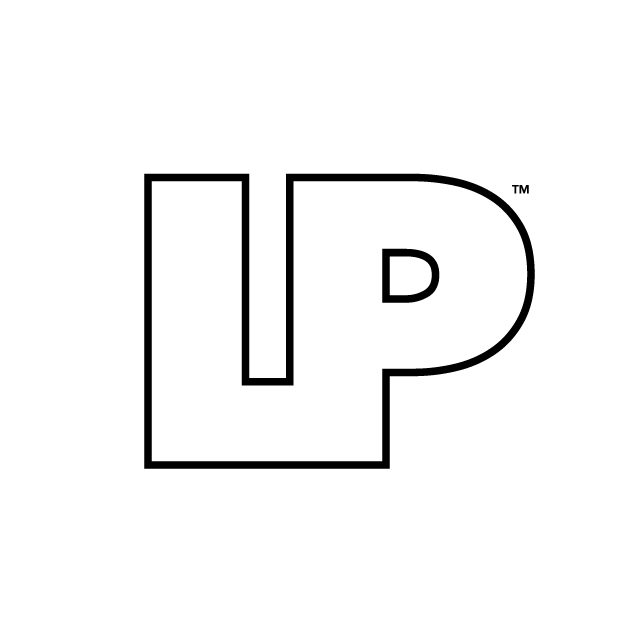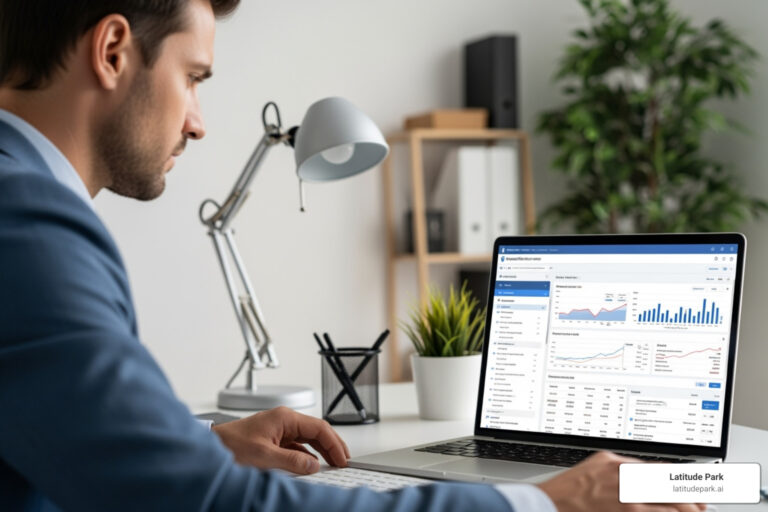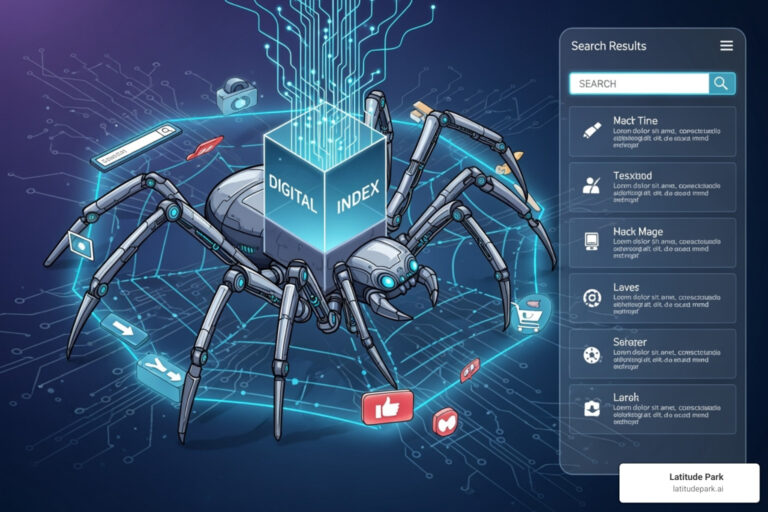Why Facebook Ad Costs Aren’t a Mystery
How much do Facebook ads cost in 2025? Here’s the quick answer:
Average Facebook Ad Costs:
- Cost Per Click (CPC): $0.26 – $0.69
- Cost Per 1,000 Impressions (CPM): $8.96 – $14.40
- Cost Per Lead (CPL): $5.83 – $8.68
- Cost Per Action (CPA): $8 – $55
- Monthly Budget: Most businesses spend $100 – $500/month
If you’re managing Facebook ads for multiple franchise locations, you’ve probably asked this question dozens of times. The truth is, Facebook advertising costs aren’t fixed. They shift based on your audience, strategy, and campaign management.
With over three billion monthly active users, Facebook remains a powerful advertising platform. It offers incredible flexibility—you can start with just $1 per day or scale to thousands. Unlike traditional advertising, Facebook lets you control every dollar and measure your exact return.
What makes Facebook different is that you’re not buying ad space, you’re bidding for it. You enter an auction against other advertisers targeting similar audiences. Your costs depend on factors like your bid strategy, ad quality, audience competition, and even the time of year. The good news? Once you understand how the system works, you can dramatically reduce your costs while improving your results.
I’m Rusty Rich, President and founder of Latitude Park, and I’ve helped countless franchise brands optimize their Facebook ad spend since 2009. I’ve learned exactly what drives how much do Facebook ads cost and how to make every dollar work harder.
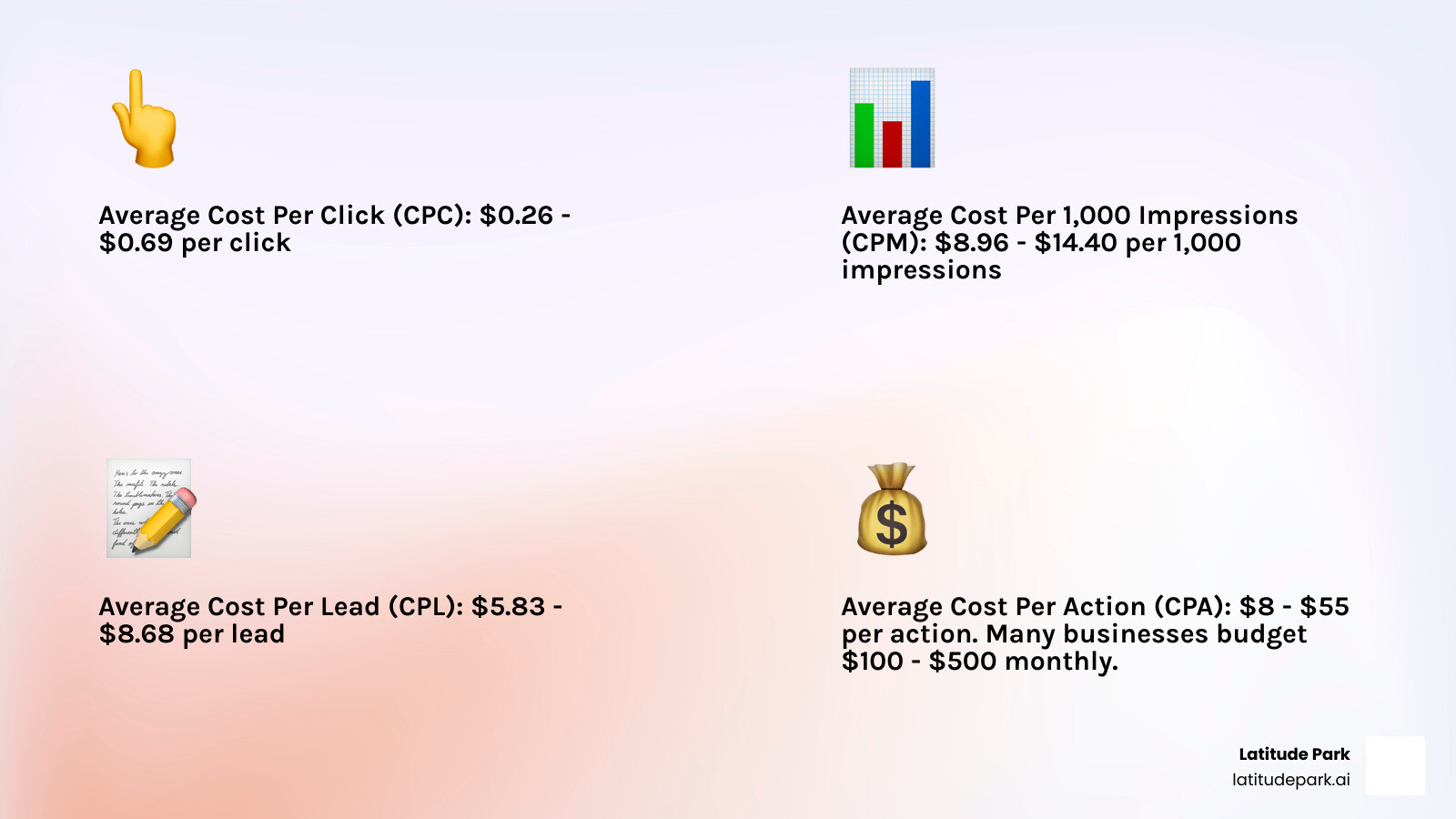
Decoding the Bill: Average Facebook Ad Costs in 2025
When planning your Facebook advertising budget, you need concrete benchmarks. The question of how much do Facebook ads cost doesn’t have a single answer, but understanding typical ranges helps you set realistic expectations and gauge campaign performance.
Each metric tells a different story about your campaign and helps you understand where your money is going.
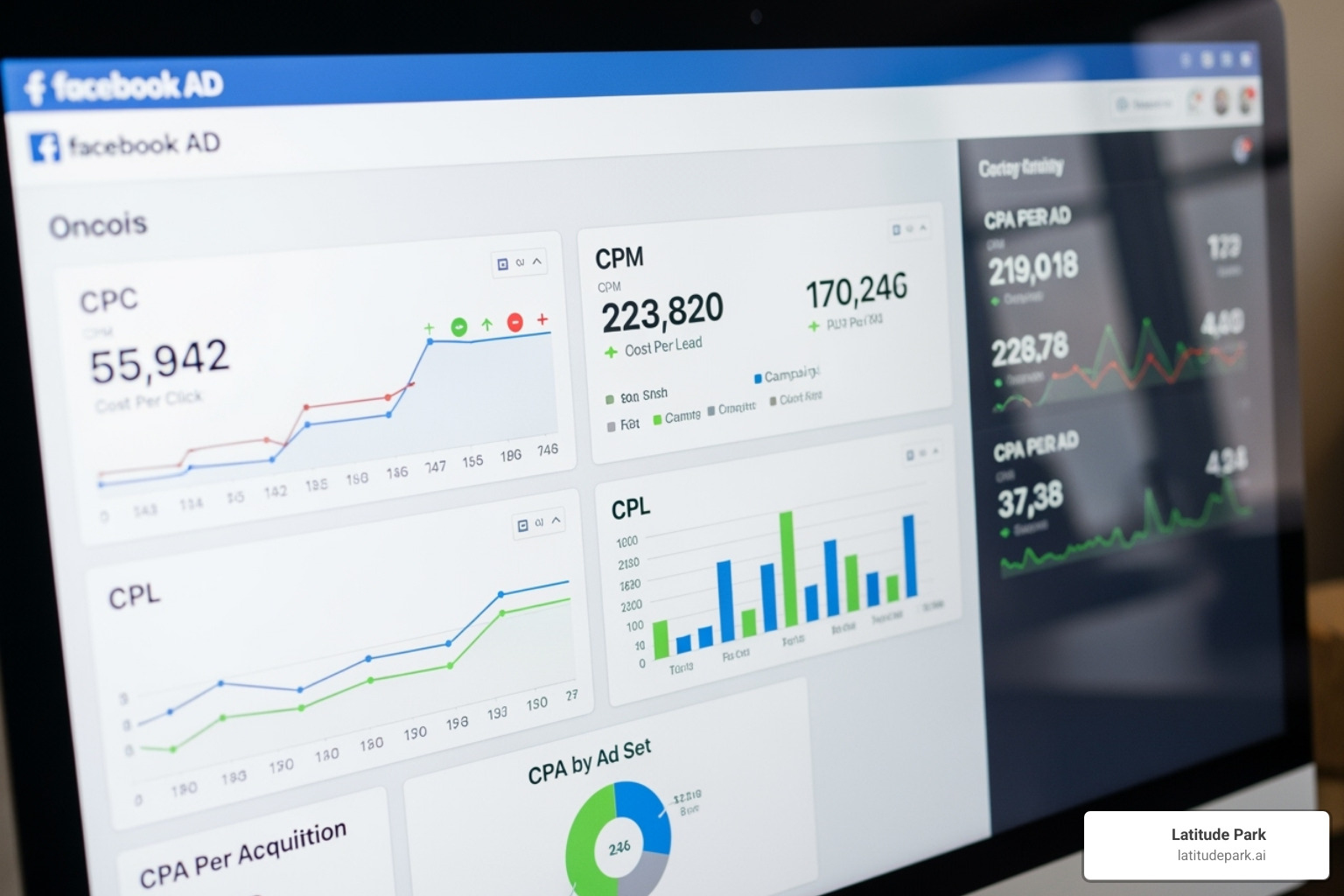
What is the average Cost Per Click (CPC)?
Cost Per Click (CPC) is the average amount you pay each time someone clicks your ad. It’s a key metric for driving traffic to a website or landing page.
In 2025, Facebook’s average CPC is around $0.44, with a typical range between $0.26 and $0.69. A lower CPC means you get more traffic for the same budget. Your click-through rate (CTR) directly impacts your CPC; when more people click your ad relative to how many see it, Facebook rewards you with lower costs.
What is the average Cost Per 1,000 Impressions (CPM)?
Cost Per Mille (CPM), or cost per thousand impressions, is what you pay to show your ad to 1,000 people. This is your go-to metric for brand awareness campaigns where visibility is the primary goal.
The current average CPM for Facebook ads is $12.58, with a typical range between $8.96 and $14.40. A lower CPM means your ad budget stretches further, putting your brand in front of more people.
What is the average Cost Per Lead (CPL)?
Cost Per Lead (CPL) shows how much you’re paying to acquire a single lead, such as an email signup or a contact form submission. For franchise businesses, this metric is often the most important.
In 2025, the average CPL for Facebook ads ranges from $5.83 to $8.68. This is remarkably affordable for acquiring contact information from someone interested in your offer. The key is ensuring these leads are high-quality, which is why pairing CPL with conversion tracking is essential.
Other Common Cost Models
Facebook offers other ways to measure advertising, each suited to different goals. Cost Per Action (CPA) tracks what you pay for specific actions like purchases or app downloads, typically ranging from $8 to $55. Cost Per Engagement (CPE) measures interactions like likes and comments, often costing just $0.01 to $0.02. For mobile apps, Cost Per Install (CPI) averages around $2.75. Boosted posts are another common tool, allowing you to spend anywhere from $1 to $100 daily to increase a post’s reach.
Most businesses spend between $100 and $500 monthly on Facebook ads. These numbers are averages and serve as starting points. Your actual costs will depend on your industry, audience, and ad quality.
How Much Do Facebook Ads Cost? Unpacking the Ad Auction & Key Factors
Understanding how much do Facebook ads cost means looking at Facebook’s ad auction system. You’re not buying ad space at a fixed rate; you’re entering a real-time auction every time your ad could appear to a user. The highest bidder doesn’t always win.
Facebook’s ad auction is blind, meaning you never see what others are bidding. The system balances your interests as the advertiser, the user’s experience, and Facebook’s own goals. The ad that offers the highest total value wins. This value is determined by three core elements: your bid, estimated action rates (the likelihood someone will take your desired action), and ad quality. This means a highly relevant, engaging ad can beat a higher bid every time. You can explore more details about how the ad auction works directly from Meta.
Let’s dig into the specific factors that shape your costs.
Factor 1: Your Bidding Strategy
Your bidding strategy is your playbook for the auction. Spend-based bidding is Facebook’s default, where the platform maximizes results within your budget. Goal-based bidding lets you specify a desired outcome, and Facebook optimizes to hit that target. Manual bids and bid caps give you direct control, but require careful monitoring. You’ll also choose between a daily budget for consistency and a lifetime budget for flexibility. For franchises, goal-based bidding often delivers the best balance of control and performance.
Factor 2: Ad Quality and Relevance
The quality and relevance of your ads dramatically impact your costs. Facebook prioritizes user experience, so better ads pay less and perform better. For example, a weak ad with a low relevance score might cost $0.14 per click, while a strong ad for the same campaign could cost just $0.03 per click. That’s nearly five times cheaper for the exact same campaign, just with better creative.
Facebook’s ad relevance diagnostics tool breaks down performance into quality, engagement, and conversion rate rankings. These are direct signals about whether you’re overpaying. High-quality creative doesn’t just perform better—it literally costs less to run.
Factor 3: Audience Targeting
Your target audience shapes everything. While it’s wise to start broader to give Facebook’s algorithm room to learn, you’ll eventually want to narrow your focus. Location, demographics, interests, and behaviors all define your audience. Custom Audiences let you reach people who’ve already interacted with your business, while Lookalike Audiences help you find new people who share characteristics with your best customers. The competition for your audience directly affects costs, with retargeting campaigns often delivering the lowest costs because you’re reaching a warmer audience.
Factor 4: Ad Placement and Format
Where your ads appear and how they look influence what you pay. Facebook offers numerous ad placements across its ecosystem: Facebook Feed, Messenger, Instagram, Stories, Reels, and the Audience Network. Each has different costs. Your ad format—Image, Video, Carousel, or Stories ads—also matters. Testing is key to finding what works best for your goals. For most advertisers, Facebook’s automatic placements option delivers the best results.
Factor 5: Seasonality and Timing
Timing affects your costs. Seasonality creates massive swings, with the fourth quarter (Black Friday, Cyber Monday, and holidays) seeing costs spike dramatically as competition intensifies. We also see patterns within weeks and days. For franchise businesses, local events and regional seasonality add another layer. Understanding these rhythms lets you adjust budgets strategically.
Factor 6: Your Industry
Your industry sets a baseline for what you’ll pay. Legal services and finance typically see the highest costs, as businesses can afford to pay more per lead. Apparel and real estate are also competitive. Restaurants and food businesses often enjoy lower costs due to their local nature. Industry benchmarks matter, but your strategy, creative, and targeting make the real difference in what you ultimately pay.
8 Proven Strategies to Reduce Your Facebook Ad Spend
Understanding the factors that influence costs is the first step; the next is taking action. We’ve honed these strategies over years of managing campaigns for franchises, and they’re incredibly effective at reducing Facebook ad costs while improving ROI.
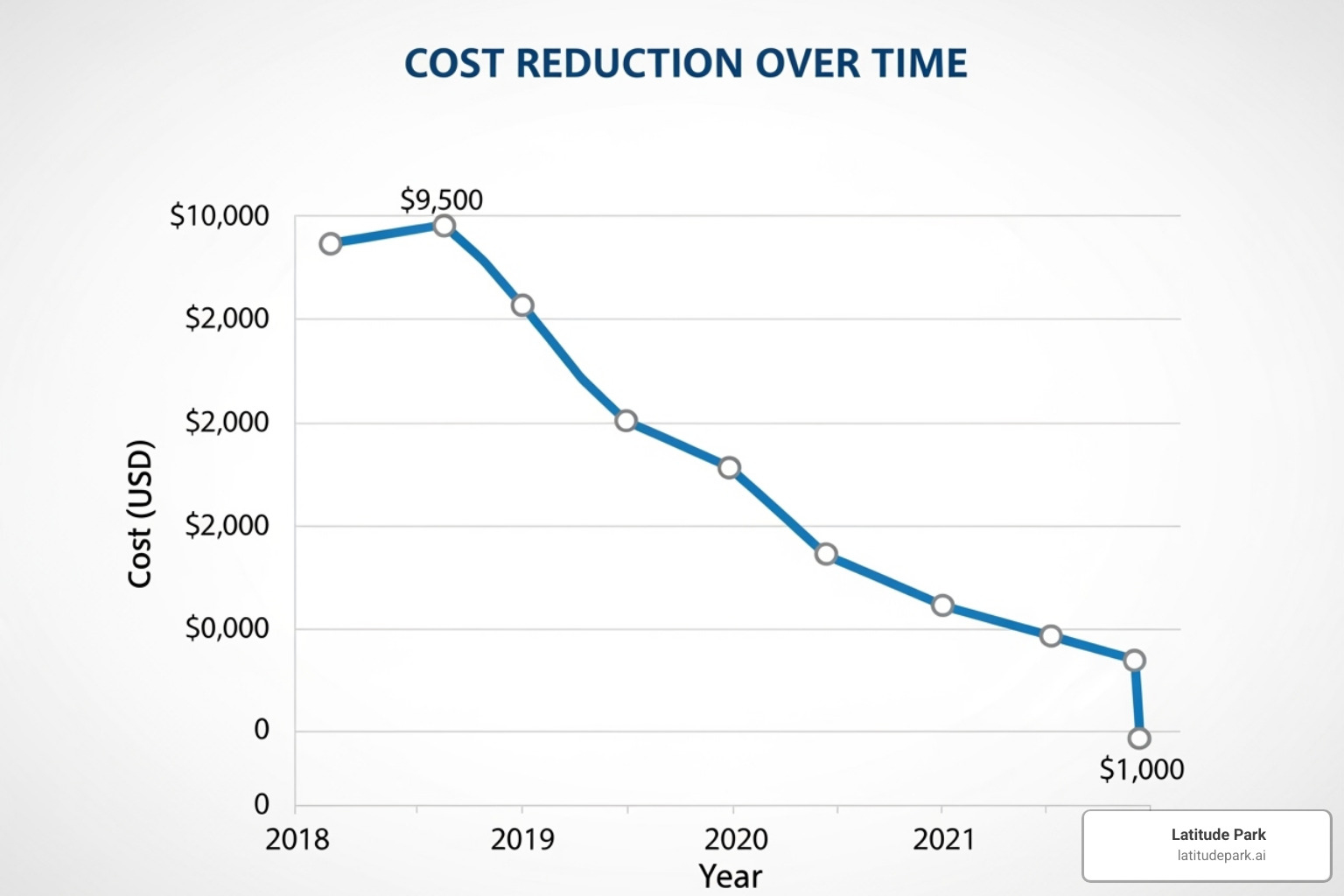
1. Align Your Campaign Objective with Your Goal
This might seem obvious, but it’s a common pitfall. Facebook offers various objectives: Awareness, Traffic, Engagement, Leads, and Sales. Each tells the algorithm what to optimize for. If your goal is website visitors (Traffic) but you select “Engagement,” Facebook will show your ad to people likely to like or comment, not click. This misalignment leads to wasted spend. Always choose the objective that directly matches your desired business outcome.
2. Refine and Test Your Audience Targeting
Precision targeting is key to reducing wasted ad spend. While starting broader helps the algorithm learn, you should eventually refine your audience to reach those most likely to convert. This involves narrowing interests and demographics, excluding irrelevant audiences (like existing customers), and layering interests to create a highly specific audience. Continuously test and refine audience segments to ensure you’re reaching the right people.
3. Leverage the Power of Retargeting
Retargeting ads are often the cheapest to run. These campaigns focus on people who have already shown interest in your business—they’ve visited your website, engaged with your content, or are on your customer lists. These audiences are “warmer” and often convert at a lower cost. Examples include abandoned cart ads and ads targeting recent website visitors. These campaigns are highly effective because you’re reminding them of something they already know.
4. A/B Test Everything
A/B testing is your secret weapon for continuous improvement. Facebook’s A/B testing feature allows you to compare different versions of your ads to see what resonates best. Test elements like ad creatives (images vs. videos), ad copy, placements, and audiences. By systematically testing, you can identify winning combinations that reduce costs and boost performance.
5. Monitor Ad Frequency
Ad frequency is the average number of times a person sees your ad. Too much repetition leads to “ad fatigue,” where users ignore or hide your ads. If your frequency creeps beyond two or three, it’s time to refresh your creatives or expand your audience. A frequency closer to one often correlates with lower advertising costs. Use frequency caps in Ads Manager to prevent overexposure.
6. Improve Your Ad’s Quality and Relevance Score
As discussed, ad quality directly impacts costs. High-quality ads are rewarded with lower auction prices. Focus on compelling creative, a clear value proposition, and relevant messaging that speaks to your audience’s needs. We regularly use Facebook’s ad relevance diagnostics tool to assess performance and make adjustments.
7. Optimize the Post-Click Experience
Your ad might be brilliant, but if the landing page is slow, confusing, or not mobile-friendly, you’re wasting money. A one-second improvement in site speed can increase conversions by 27%. Since most Facebook users are on mobile, a responsive and fast-loading mobile experience is non-negotiable. Ensure your landing page content directly matches the ad to create a seamless user journey.
8. Let the Learning Phase Complete
When you launch a new campaign, Facebook’s algorithm enters a “learning phase” to find the most efficient way to deliver your ads. This typically requires around 50 optimization events (e.g., 50 conversions) within a week. It’s crucial to avoid significant edits during this phase, as this can reset the process and lead to higher initial costs. Allow the algorithm to gather enough data before making major changes.
Facebook Ad Costs in the Social Media Landscape
To plan your strategy, it helps to understand where Facebook fits in the bigger picture. Comparing how much do Facebook ads cost to other platforms helps you make smarter investment decisions.

Understanding Facebook Ad Costs in Context
Facebook’s costs are competitive. With a CPC from $0.26 to $0.69 and a CPM between $8.96 and $14.40, it sits in a sweet spot. Here’s how it compares:
- Instagram: Often has a lower CPM (averaging $6.70) because its visual format drives higher engagement.
- TikTok: Averages a $1 CPC and $10 CPM but requires a higher minimum daily budget ($50 at the campaign level).
- Pinterest: Effective for visual brands, with CPCs of $0.10 to $1.50 and very low CPMs of $2 to $5.
- LinkedIn: A premium B2B platform with a high CPC of $5.26, reflecting the high value of its audience.
- YouTube: Operates on a cost-per-view model, typically $0.10 to $0.30 per view.
- Twitter (X): Charges $0.50 to $2.00 per action, though recent changes have created some uncertainty.
Across all platforms, the average CPC ranges from $0.38 to $5.26, showing that platform choice is critical.
Key Takeaways for Platform Selection
How do you decide where to spend your budget? Consider these factors:
- Audience Demographics: Target Gen Z on TikTok, professionals on LinkedIn, or a broad range of users on Facebook and Instagram.
- Campaign Objectives: Use Instagram or TikTok for brand awareness, but lean on Facebook for its powerful conversion optimization.
- Content Style: Your content should match the platform. Stunning visuals work best on Instagram and Pinterest, while educational content thrives on YouTube or LinkedIn.
- Budget Flexibility: Facebook’s low entry point makes it ideal for testing and scaling, which is why understanding how much do Facebook ads cost is so valuable from day one.
The most successful strategies often integrate multiple platforms. Facebook frequently serves as the foundation due to its massive reach, superior targeting, and proven track record.
Budgeting, Management, and Measuring Success
Once you understand how much do Facebook ads cost, the next step is budgeting for them and measuring success. These are the questions we help our franchise clients steer every day.
How much of your overall advertising budget should you allocate to Facebook ads?
There’s no magic formula, but a common guideline for established businesses is to allocate 5% to 15% of the total advertising spend to Facebook ads. If you’re just starting, begin small and scale based on data. You can start with as little as $5 per day for traffic or sales objectives. The key is to test with a modest budget, identify what’s working, and then increase spend on winning campaigns.
What are the costs of managing Facebook ads?
The ad spend itself is only part of the equation. You also need to factor in management costs, which vary by approach:
- In-house: A dedicated Facebook Ads Manager can command a salary of $50,000 to $100,000 annually.
- Freelancers: Rates typically range from $25 to $100+ per hour, or a monthly retainer.
- Agency Partnerships: Monthly retainers can range from $500 to $5,000+, depending on the scope of work. For franchises managing multiple locations, this investment often pays for itself through specialized expertise and efficiency.
Are there hidden costs associated with Facebook advertising?
Several costs are easy to overlook. Content creation is a big one; compelling visuals and copy are essential and have associated costs. If you’re sending traffic to a landing page, its development and optimization are crucial. You might also invest in third-party tools for analytics or management. Finally, successful campaigns lead to more inquiries, which may require scaling your customer support. Budgeting for these expenses upfront provides a clearer picture of your true ROI.
How can businesses measure the ROI of their Facebook ad campaigns?
Measuring ROI is where the rubber meets the road. The basic calculation is simple: compare the revenue generated from ads against the total cost of running them. To do this accurately, tracking conversions properly is non-negotiable. The Facebook Pixel and Conversions API are tools that track user actions on your website after they click an ad.
For e-commerce, conversion value is the sale amount. For lead generation, you must estimate a lead’s value based on your conversion rates. Smart businesses also consider Customer Lifetime Value (CLV) to understand the long-term worth of a customer acquired through Facebook. By tracking these metrics, you can definitively prove profitability and double down on what works.
Frequently Asked Questions about Facebook Ad Costs
Over the years, we’ve answered countless questions about how much do Facebook ads cost. Here are the answers to the most common ones.
What is a good daily budget for Facebook ads?
If you’re just starting, a budget of $10-$20 per day is a good sweet spot. This gives Facebook’s algorithm enough data to begin optimizing without a major upfront investment. The absolute minimum is $1 per day for impression campaigns or $5 for click-based campaigns, but higher budgets yield faster learnings. Once you identify a winning campaign, you can gradually increase your daily budget.
How much do Facebook ads cost for a small business?
Most small businesses find success spending between $100 and $500 per month on Facebook ads. This allows for meaningful local targeting and consistent lead generation without breaking the bank. The platform’s scalability is a major advantage; you can start small, prove ROI, and then confidently increase your spend based on profitable results.
Are Facebook ads still worth the money in 2025?
Yes, emphatically. Facebook’s unparalleled reach of over three billion monthly users across its apps remains a massive advantage. Its advanced targeting capabilities allow for a level of precision that is difficult to match, letting you reach your ideal customer with incredible accuracy. Most importantly, the measurable ROI is clear. With industry averages showing a return between 2:1 and 5:1, Facebook ads remain a cornerstone of effective digital marketing when executed correctly.
Conclusion: Take Control of Your Facebook Ad Budget
Navigating Facebook ad costs might seem complex, but it’s far from a mystery. By understanding the ad auction and the key factors influencing costs, you can take control. The answer to how much do Facebook ads cost is largely up to you.
By implementing proven strategies like aligning objectives with goals, refining targeting, and relentless testing, you can significantly reduce ad spend while boosting results. With the right knowledge, you can turn your Facebook ad budget into a powerful engine for business growth.
At Latitude Park, we specialize in helping franchises master their Meta advertising. We craft custom campaign structures that drive growth for multi-location businesses. Ready to optimize your ad spend? Let us help you develop a tailored strategy that delivers exceptional ROI.
